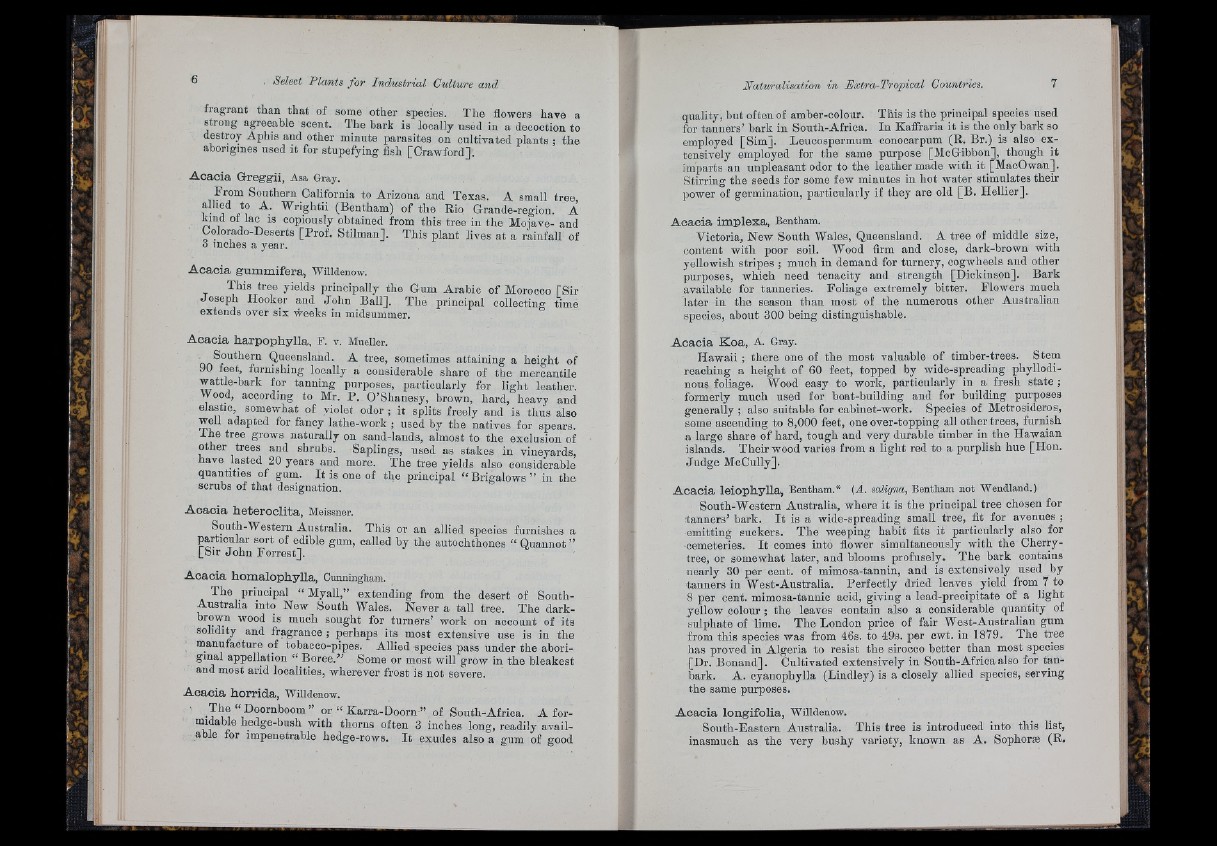
fragrant than th a t of some other species. The flowers have a
strong agreeable scent. The bark is locally used in a decoction to
destroy Aphis and other minute parasites on cultivated plants ; the
aborigines used it for stupefying fish [Crawford],
A c a c ia Greg-gii, Asa Gray.
From Southern California to Arizona and Texas. A small tree,
allied to A. Wrightii (Bentham) of the Rio Grande-region. A
kind of lac is copiously obtained from this tree in the Mojave- and
Colorado-Deserts [Prof. Stilman]. This plant lives at a rainfall of
3 inches a year.
A c a c ia g um m ife ra , Willdenow.
This tree yields principally the Gum Arabic of Morocco [S ir
Joseph Hooker and John Ball]. The principal collecting time
extends over six fimeks in midsummer.
A c a c ia h a rp o p h y lla , P. v. Mueller.
Southern Queensland. A tree, sometimes attaining a height of
90 feet, furnishing locally a considerable share of the mercantile
wattle-bark for taniiiug purposes, particularly for light leather.
Wood, according to Mr. P . O’Shanesy, brown, hard, heavy and
elastic, somewhat of violet odor ; it splits freely and is thus also
well adapted for fancy lathe-work ; used by the natives for spears,
Ih e tree grows naturally on saiid-lands, almost to the exclusion of
other trees and shrubs. Saplings, used as stakes in vineyards,
have lasted 20 years and more. The tree yields also considerable
quantities of gum. I t is one of the principal “ Brigalows ” in the
scrubs of th a t designation.
A c a c ia h e te ro c lita , Meissner.
South-Western Australia. This or an allied species furnishes a
particular sort of edible gum, called by the autochthones “ Quannot ”
(_Sir John Forrest].
A c a c ia h om a lo p h y lla , Cunningham.
The principal “ Myall,” extending from the desert of South-
Austraha into New South Wales. Never a tall tree. The dark-
brown wood is much sought for turners’ work on account of its
solidity and fragrance ; perhaps its most extensive use is in the
manufacture of tobacco-pipes. Allied species pass under the abori-
ginal appellation “ Boree.^^ Some or most will grow in the bleakest
and most arid localities, wherever frost is not severe.
A c a c ia h ó r r id a , Willdenow.
• The “ Doornboom” or “ Karra-Doorn” of South-Africa. A formidable
hedge-bush with thorns often 3 inches long, readily available
for impenetrable hedge-rows. I t exudes also a gum of good
quality, but often of amber-colour. This is the principal species used
for tanners’ bark in South-Africa. In Kaffraria it is the only bark so
employed [Sim], Leucospermum conooarpum (R. Br.) is also extensively
employed for th e same purpose [McGibbon], though it
imparts an unpleasant odor to the leather made with it [MacOwan].
Stirring the seeds for some few minutes in hot water stimulates their
power of germination, particularly if they are old [B. Hellier].
A c a c ia im p le x a , Bentham.
Victoria, New South Wales, Queensland. A tree of middle size,
content with poor soil. Wood firm and close, dark-brown with
yellowish stripes ; much in demand for turnery, cogwheels and other
purposes, which need tenacity and strength [Dickinson]. Bark
available for tanneries. Foliage extremely bitter. Flowers much
later in the season than most of the numerous other Australian
species, about 300 being distinguishable.
A c a c ia K o a , A. Gray.
Hawaii ; there one of the most valuable of timber-trees. Stem
reaching a height of 60 feet, topped by wide-spreading phyllodi-
nous foliage. Wood easy to work, particularly in a fresh state ;
formerly much used for boat-building and for building purposes
generally ; also suitable for cabinet-work. Species of Metrosideros,
some ascending to 8,000 feet, one over-topping all other trees, furnish
a large share of hard, tough and very durable timber in the Hawaian
islands. Their wood varies from a light red to a purplish hue [Hon.
Judge McCully].
A c a c ia le io p h y lla , Bentham.* {A. saligna, Bentham not Wendland.)
South-Western Australia, where it is the principal tree chosen for
tanners’ bark. I t is a wide-spreading small tree, fit for avenues ;
emitting suckers. The weeping habit fits it particularly also for
■cemeteries. I t comes into flower simultaneously with the Cherry-
tree, or somewhat later, and blooms profusely. The bark contains
nearly 30 per cent, of mimosa-tannin, and is extensively used by
tanners in West-Australia. Perfectly dried leaves yield from 7 to
8 per cent, mimosa-tannic acid, giving a lead-precipitate of a light
yellow colour ; the leaves contain also a considerable quantity of
sulphate of lime. The London price of fair West-Australian gum
from this species was from 46s. to 49s. per cwt. in 1879. The tree
has proved in Algeria to resist the sirocco better than most species
[Dr. Bonand]. Cultivated extensively in South-Africa also for tan-
bark. A. cyanophylla (Bindley) is a closely allied species, serving
the same purposes.
A c a c ia lo n g ifo lia , Willdenow.
South-Eastern Australia. This tree is introduced into this list,
inasmuch as the very bushy variety, known as A. Sophoræ (R.